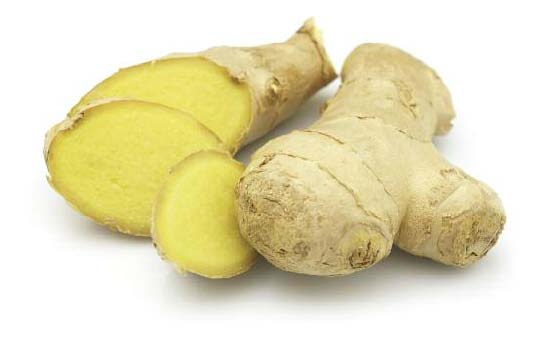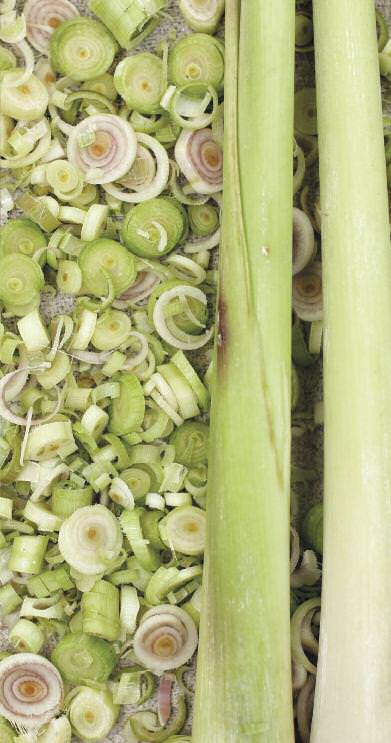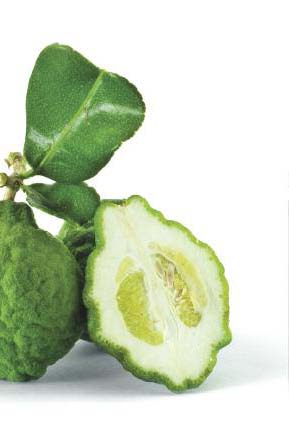edible garden
GROWING EXOTICS
Cultivate your own Southeast Asian seasonings this winter.
WRITTEN BY KAY FAHEY
Southeast Asia may have the perfect cuisine. Rich in complex and vibrant flavors, it abounds in healthful ingredients. Best of all, its exotic seasonings create countless variations of deliciousness.
It’s these seasonings that define the cooking of Southeast Asia, and they are what make it so difficult to achieve at home. Try to duplicate the wonders you’ve sampled in Thai and Vietnamese restaurants and you’re likely to be frustrated with the results.
Fresh cilantro, Thai basil, and mint are easily found at the grocery store. But just try finding fresh kaffir lime leaves. And as for those desiccated specimens of lemongrass, you may as well leave them on the shelf. These two seasonings impart an aromatic, citrusy element crucial to Southeast Asian cookery. Even ginger, which makes a decent substitute for galangal, is likely to be old and tough. Tender, young ginger, bursting with spicy juices, packs a far tastier punch.
There really is only one solution. Just as we grow a kitchen garden of European herbs in a sunny window, it’s surprisingly easy to maintain pots of Asian seasonings throughout the winter. All you need is warmth, moisture, and light.

Indoor Asian Garden
As these are tropical plants, they won’t make it outdoors during our winters. But they will grow indoors. They require substantial light, so you want to put them in the brightest spot you have. They’ll do best with top-quality organic potting soil and fertilizer. They’re pest resistant, but just in case, use insecticidal soap for most pests. If scale appears, remove it by hand with a Teflon scrubber. Employ an insecticide that is vegetable and fruit rated for kaffir lime and lemongrass, as the sprayed portion is used in cooking.
Jon Bruyn, horticulturist at Moana Nursery in Reno and an expert on growing citrus, advises planting kaffir lime trees in a large container filled with soil that has plenty of perlite. Give it even moisture and don’t fertilize during the winter.
“A lot of people love to fertilize and over-water,” Bruyn says. “That’s the death of citrus.”
Virginia Johnson, co-owner of Custom Gardens in Silver Springs, grows and sells ginger. Growing ginger, she emphasizes, is a long-term project, requiring nine to 11 months to reach maturity. The pros at Custom Gardens insist on using only soil and fertilizer with the Organic Materials Review Institute (OMRI) seal of approval.
Growing ginger begins with rhizomes (such as iris). They need plenty of room in the pot, as it’s important to mound soil on top as they grow. After a month or so, shoots will appear, and eventually the little bumps on the rhizome will produce juicy, tender “fingers” ready for harvest.
“Be sure you start with edible ginger,” Johnson cautions. “A lot of ginger plants are ornamental only.”
Both Johnson and Lisa Braginton, horticulturist with Moana Nursery, advise letting the surface soil dry out between waterings when growing ginger. Meanwhile, lemongrass, Braginton says, needs even moisture and regular feeding, so long as its other needs, such as abundant light, are met.
Provide a few simple basics and these tropical beauties will give you an abundance of fresh, exotic seasonings. You’ll be harvesting from your indoor winter garden to create tantalizing Southeast Asian dishes for years to come.
Freelance writer Kay Fahey’s kaffir lime tree is more than 10 years old and still going strong.
 Chicken Coconut Soup
Chicken Coconut Soup
(adapted from True Thai by Victor Sodsook. Serves 4 to 6)
3 cups chicken broth
8 large slices peeled ginger (about 5 ounces)
1 or 2 large stalks lemongrass
12 fresh kaffir lime leaves, torn in half
2 14-ounce cans unsweetened coconut milk
1 pound boneless, skinless chicken breast
2 tablespoons chili-tamarind paste (nam prik pao)
¼ cup fresh lemon juice
2½ tablespoons coconut palm sugar or golden brown sugar
2½ tablespoons fish sauce
½ pound mushrooms, sliced
5 small Thai chiles or other hot chiles, de-stemmed and lightly crushed
Remove tough outer leaves of lemongrass and trim to 12 inches. Angle-cut stem into 2-inch pieces.
In a stockpot, gradually bring to a boil chicken broth, ginger, lemongrass, and lime leaves. Boil 1 minute. Stir in coconut milk and return to a boil. Stir in chicken and return to a boil. Add chili-tamarind paste, lemon juice, sugar, and fish sauce. Stir until chili-tamarind paste and sugar are dissolved. Add mushrooms and simmer just until tender. Ladle into tureen or bowls and float chiles on top to serve.
Plants for the Asian Garden
Lemongrass
Kaffir lime
Ginger
Thai basil
Cilantro
Mint
Resources
Moana Nursery
1190 W. Moana Lane, Reno, 775-825-0602; 11301 S. Virginia St., Reno, 775-853-1319; and 7655 Pyramid Hwy., Sparks, 775-425-4300; http://www.Moananursery.com
Custom Gardens
3701 Elm St., Silver Springs, Nev.
775-577-2069, http://www.Customgardens-organic-farm.com
Seeds of India
http://www.Seedsofindia.com
TropicalsUSA
http://www.Tropicalsusa.com


